Acknowledgments
This project was funded by the United States Department of Agriculture (USDA), National Institute of Food and Agriculture, under agreement 2008-51130-19537, also known as the Southern Region Water Resource Project. The publication summarizes Florida results of a national project conducted by Robert Mahler, Professor of Soil and Environmental Sciences at the University of Idaho. The project was supported in part by the Southern Region Water Policy and Economics program team led by Michael D. Smolen, Oklahoma State University, Leeann DeMouche, New Mexico State University, and Donn Rodekohr, Auburn University. Damian Adams, University of Florida, and Alyssa Dodd, Department of Environmental Resources Management (Palm Beach County, Florida), were instrumental in the development of this survey. The authors also would like to acknowledge editorial suggestions for this publication by Rodney Clouser, Carol Fountain, and Travis Prescott, University of Florida.
Introduction
This publication summarizes responses to the survey questions about the drinking water in Florida, and is part of a series describing a survey of Florida residents about water resource issues. The purpose of the survey titled Water Issues in Florida was to examine Florida residents' awareness and attitudes about water quality and quantity issues and the strategies to protect water resources. The survey was designed by researchers at the University of Idaho, University of Florida, Florida A&M University, and other cooperating institutions within the United States Department of Agriculture's Southern Regional Water Program, and was implemented by the University of Idaho as a part of a national project. The survey included questions about water resource issues in Florida, actions to protect water resources, drinking water quality, quality of ground and surface water, water availability, participation in educational and volunteer programs, and socio-demographics.
Socio-Demographic Characteristics of Survey Respondents
The survey was mailed to 1,154 randomly selected Florida households in the fall of 2008 and spring of 2009; 523 households completed and returned the survey (45.5% response rate). The majority of survey respondents had at least a high school diploma (97%), were male (68%), and were at least sixty years old (60%). Most survey respondents resided in a city with at least 25,000 residents (76%), had resided in Florida for at least five years (90%), and resided in Florida year-round (89%). In comparison with total Florida population, the survey respondents were much older, were more educated, and were comprised of a larger proportion of males (Table 1).
Survey respondents ranged in age from 18 to 95. Only nine respondents (or 2% of the total number of respondents) were younger than age 30. Since this number was too small to conduct any statistical analysis, respondents younger than age 30 were excluded from the statistical analyses.
Forty-three percent of respondents indicated that they resided outside city limits (the other 57% resided inside city limits). This category includes respondents engaged in farming (just seven respondents) and those not engaged in farming.
Interestingly, respondent characteristics differed depending on the size of the cities in which respondents resided. Almost one-half of respondents who had resided in Florida for more than 10 years resided in cities with populations larger than 100,000 people (Figure 1). For comparison, more than one-half of respondents who had resided in Florida for 5–10 years resided in smaller cities with populations between 25,000 and 100,000. Finally, respondents who moved to Florida relatively recently (within the last five years) resided mostly in cities larger than 100,000 people, or in cities lesser than 25,000 people. This difference in the sizes of the cities in which respondents resided was statistically significant (chi-square test, 99% confidence level).
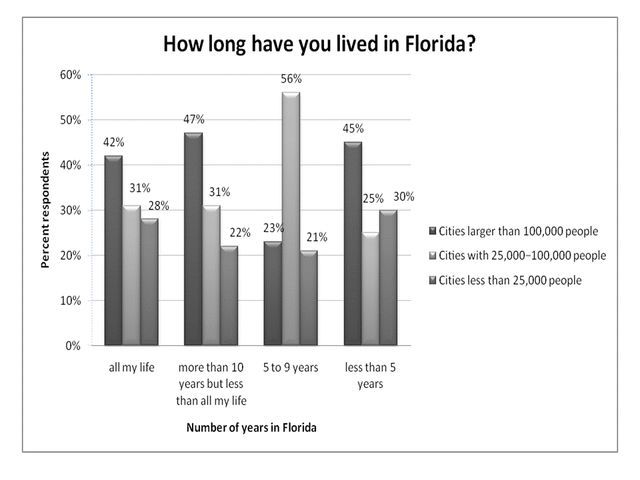
Almost one-half of respondents who resided in the state year-round resided in cities with populations greater than 100,000 people. In contrast, part-time residents lived in smaller cities with populations between 25,000 and 100,000 people, or in even smaller towns (Figure 2). This difference in the size of the cities in which respondents resided was statistically significant with 99 percent confidence level.
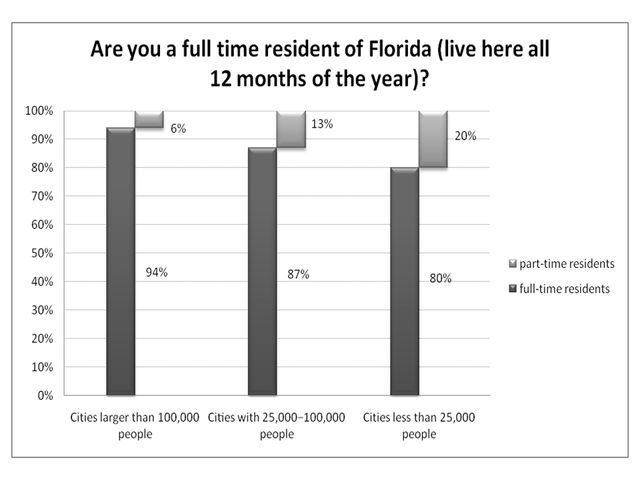
Finally, almost 60 percent of respondents between ages 30 and 50 resided in cities with populations greater than 100,000 people. For the group aged 60 or older, about one-half of respondents resided in cities with populations greater than 100,000 people, while about one-third of respondents resided in smaller cities with populations between 25,000 and 100,000 people. Among respondents who resided in cities with populations smaller than 25,000 people, 70 percent were over the age of 60 (Figure 3). This difference was statistically significant with 99 percent confidence level.
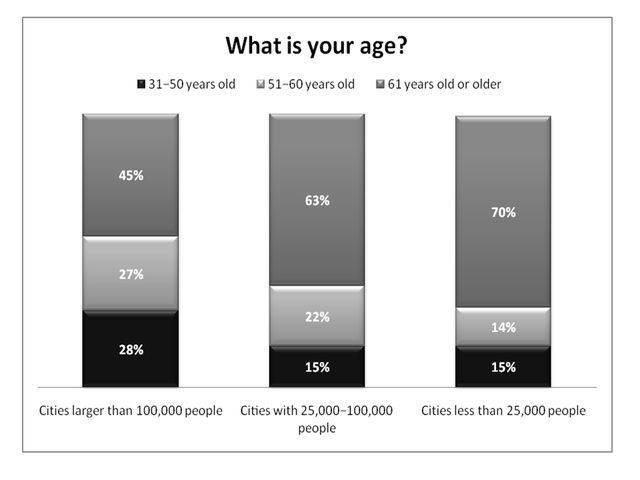
Primary Sources of Drinking Water Differed by Respondents' Demographic and Residence Characteristics
According to Marella (2008), 90 percent of Florida residents obtain their drinking water from a public supply system, while 10 percent of residents rely on domestic self-supplied water for drinking purposes. In our study, 72 percent of respondents use public supply (municipal or rural), while 15 percent rely on bottled water and 14 percent use private sources of supply, such as wells, rivers, ponds, lakes, etc. (Table 2). Four respondents did not know the source of their drinking water, so they were excluded from further analysis.
Primary drinking-water source differed by location (in city limits, outside city limits, and size of the city) and length of time respondents resided in Florida. Most respondents (74%) who resided inside city limits were on municipal water supply systems, and 18 percent of this group reported buying bottled water for drinking purposes. Only 4 percent of those residing inside city limits used private-supply sources (Figure 4). By comparison, among the respondents who resided outside of city limits, 27 percent had private-supply sources, and only 52 percent relied on municipal public water supply. Only 11 percent of these respondents used purchased bottled water as their primary source of drinking water. This difference in primary source of drinking water among respondents residing inside and outside city limits was statistically significant (chi-square test, 99% confidence level).
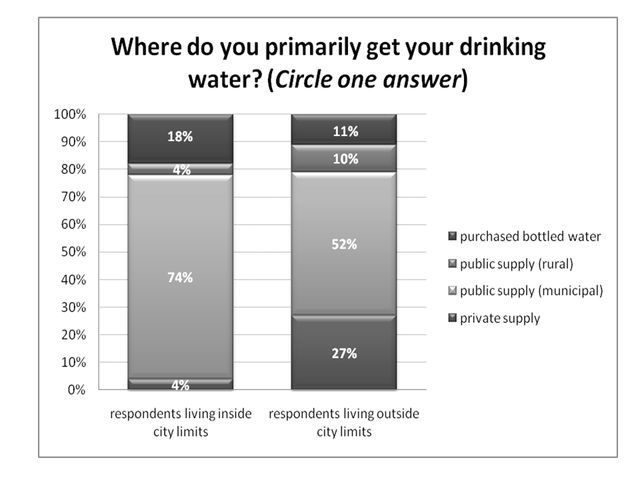
Drinking-water sources differed significantly among the cities of difference sizes (chi-square test, 99% confidence level). However, even for cities with populations greater than 100,000 people, seven percent of respondents reported having private water-supply sources. In cities with populations smaller than 25,000 people, 30 percent of respondents use water supplied through private systems for drinking purposes (Figure 5). Hence, to achieve water conservation objectives emphasized by Florida state and regional agencies (FDEP 2008) in addition to targeting the Floridians using water from public supply sources, it is important to develop special conservation programs and projects targeting Florida residents on private water supplies.

Among respondents who had resided in Florida for more than five years, the percentage of people that indicated having access to private supply was much higher (14%) than for respondents who had resided in Florida less than five years (5%). This difference may reflect changes in residential development projects in Florida, and/or changes in preferences of people who migrated to Florida in recent years. Among the respondents who had resided in Florida for more than five years, 13 percent purchased bottled water, whereas our analysis revealed a significantly higher percentage (33% purchasing bottled water) for respondents who had resided in Florida for less than five years. Also, respondents without high school diplomas reported having private water supplies or buying bottled water more frequently than respondents with high school or higher education. Additional studies are needed to explain such behavioral differences.
Perception of Public Supply
Respondents were asked about the safety of drinking water and their satisfaction with drinking-water systems. For respondents using a public supply (municipal or rural), 89 percent felt that their home tap water is safe to drink (Table 3). Younger respondents and females were less likely to believe that their tap water is safe to drink (the difference is statistically significant at 99% confidence level) (Figures 6 and 7). No statistically significant relationship between the perceived safety of tap water and the size of the respondent's city or a home's proximity to city limits was found.
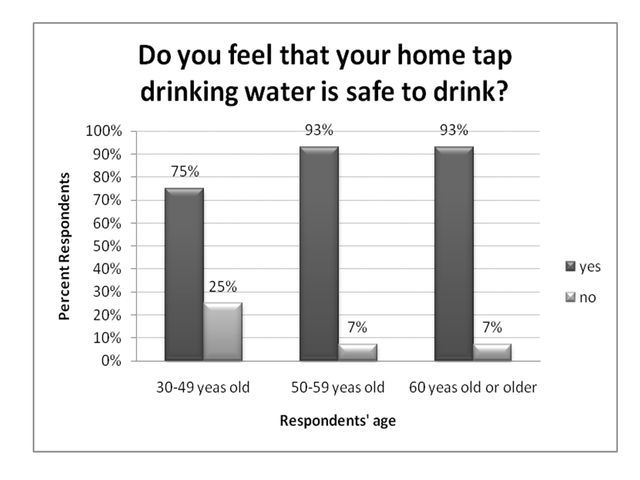
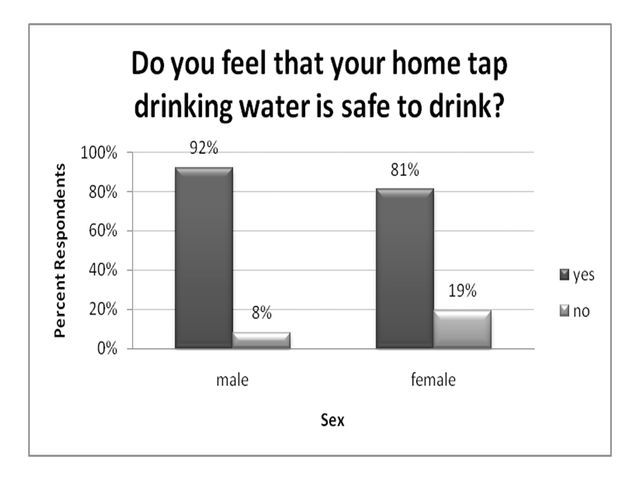
Although a large majority of respondents believed that their home tap water is safe to drink, 20 percent of respondents who used water from a public supply for drinking purposes were not satisfied with the water from their home taps (Table 3). This supports findings reported in other studies about the importance of organoleptic characteristics of tap water (i.e., taste, odor, and sight), in addition to safety (Doria 2006). The difference in the level of satisfaction between the customers of municipal and rural systems was not statistically significant. However, 24 percent of respondents on municipal or rural public water systems who resided inside city limits were not satisfied with their current drinking water in comparison with 12 percent of respondents residing outside city limits, which does present a difference of statistical significance (at 95% confidence level, chi-square test). Also, male respondents (74%) are more satisfied with their current drinking water (piped in house) than female respondents (56%).
Respondents Reported Use of a Variety of Strategies to Address Drinking Water Issues
Concerns about drinking-water safety and dissatisfaction with home tap water translated into specific actions, including testing drinking water, installing water-treatment systems, using water filters, and having a separate water supply for drinking water (Table 4).
Testing home drinking water. Nearly one-fifth of respondents (19%) have their home drinking water tested (Table 4). Respondents on private supply were much more likely to have their drinking water tested. Only 13 percent of respondents on public supply (municipal or rural) tested their home drinking water, while nearly half (49%) the respondents on private supply reported doing so (Figure 8). This difference in behavior is statistically significant (chi-square test, 99% confidence level).
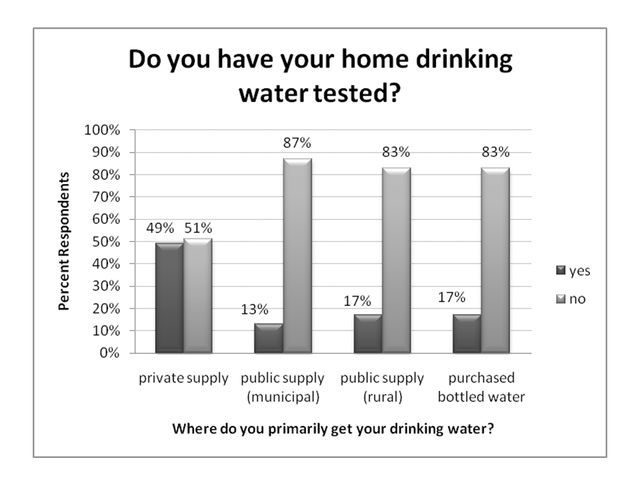
Water treatment system. Twenty-two percent of respondents had a water-treatment system (Table 4). Among the respondents on private supply, this percent was much higher (61%) (Figure 9). Only 16 percent of respondents on a public water-supply system (municipal) had a water-treatment system. This difference in behavior is statistically significant (chi-square test, 99% confidence level).
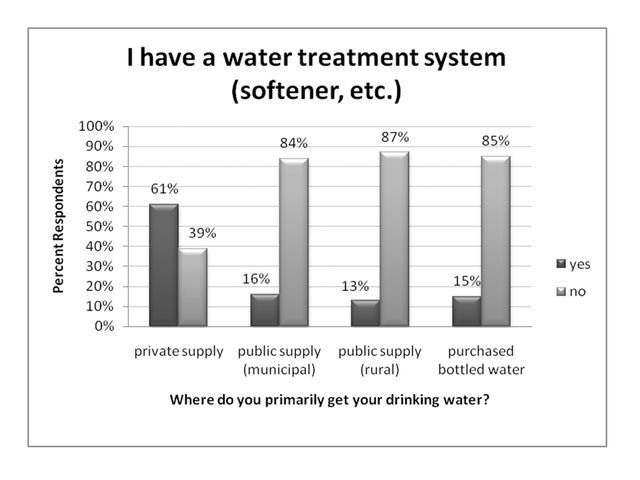
Water filters. Almost one-half of respondents had water filters (Table 4). Water filters were most popular among respondents getting drinking water from public-supply systems (rural or municipal) (52% of respondents reported having a water filter). Only 36 percent of respondents who relied on bottled water had water filters (Figure 10). This difference in behavior was statistically significant (chi-square test, 95% confidence level).

Water filters seem to be a strategy to address respondents' dissatisfaction with drinking water piped in house: 59 percent of respondents who answered "no" to the question if they are satisfied with their drinking water (piped in house) had water filters (Figure 11). By comparison, 40 percent of respondents who were satisfied with their drinking water also had water filters. This difference between respondents reporting different levels of satisfaction was statistically significant (chi-square test, 99% confidence level).
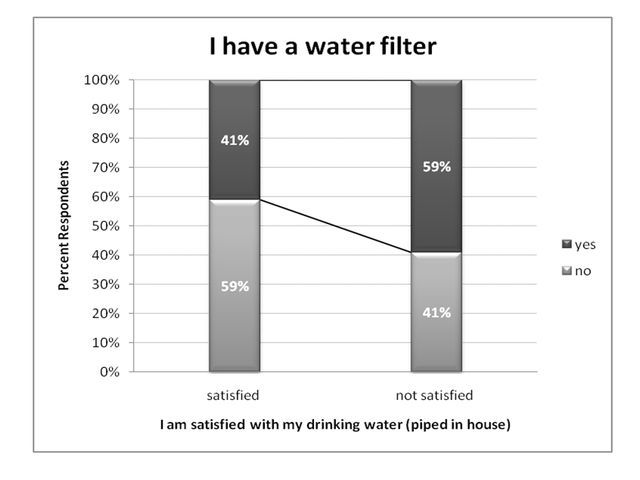
Bottled Water as a Strategy to Address Concerns with Home Tap Water
The use of bottled water was influenced by demographic characteristics, perceptions of safety, and level of satisfaction with perceived tap water quality. Overall, only 21 percent of respondents indicated that they never bought bottled water (Table 5). Fifty-one percent of respondents often use bottled water for drinking purposes, and seven percent of respondents purchase five-gallon containers of drinking water.
Among those who get their drinking water primarily from public or private supply systems, responses varied depending on the age of the respondents. Only seven percent of respondents between the ages of 30 and 50 never buy bottled water, while two-thirds of respondents in this age group often buy bottled water for drinking. In contrast, 44 percent of respondents older than age 60 (44%) often buy bottled water, while 30 percent in this age group indicated that they never purchase bottled water.
Bottled water purchase is used by respondents to address a perceived lack of safety of tap water: two-thirds of respondents who believed that tap water is not safe to drink purchased bottle water (Figure 12). Similarly, 63 percent of respondents who answered "no" to the question about their satisfaction with drinking water piped in house often purchased bottle water (Figure 13). These differences in responses were statistically significant (chi-square test, 99% confidence level).
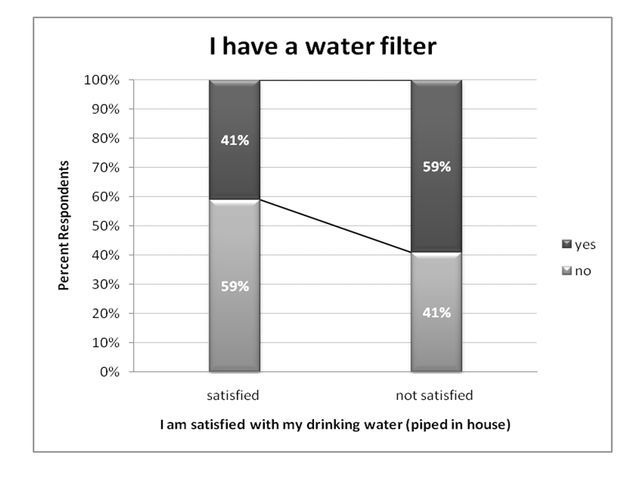
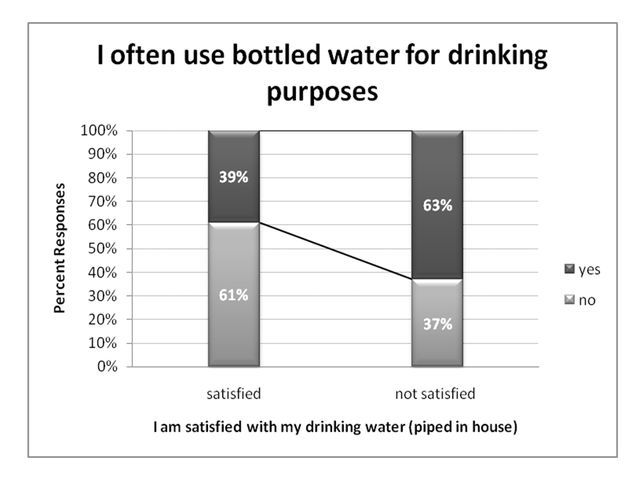
Only seven percent of respondents indicated that they purchase five-gallon containers of drinking water (Table 5). However, the percentage rises to 22 percent among respondents who did not believe that home tap water is safe to drink. Furthermore, among respondents who answered "no" to the question about their satisfaction with drinking water piped in houses, 12 percent purchase five-gallon water containers. Also, similar to the results above, respondents between ages 30 and 50 purchase five-gallon containers more often (14%), compared to people between the ages of 50 and 60 (9%), or older (4%).
Conclusions
This publication summarizes responses to the public survey conducted in Florida in 2008–2009. Specifically, we focus on attitudes and perceptions of Florida residents about drinking water. Statistical analysis was used to identify the factors that influence public attitudes and perceptions (such as age of respondents, residence inside or outside city limits, etc.). The five main findings of the publication are:
-
Florida water conservation programs should account for the fact that many Florida residents (14% overall, and 27% in rural areas) rely on a private water supply for drinking purposes. For example, conservation water rates would not be an effective strategy to induce water conservation, unless water use from private wells is metered and priced according to usage level.
-
A majority of survey respondents used publicly-supplied tap water for drinking purposes. Among them, almost 90 percent felt that their home tap water is safe to drink; however, about one-third of them answered "no" when asked whether they were satisfied with their drinking water (piped in house). Dissatisfaction may be related to taste, odor, or sight of water (Doria 2006). Furthermore, about one-half of respondents who used publicly-supplied water for drinking purposes had water filters (often used to address respondents' dissatisfaction with drinking water piped in house).
-
Respondents who relied on private water supply systems employed different strategies related to their drinking water. About one-half of the respondents who relied on a private water supply had their home drinking water tested, and almost two-thirds had a water-treatment system (softener, etc.).
-
Almost one-half of respondents often use bottled water for drinking purposes, and bottled water is often correlated with either safety concerns or general dissatisfaction with home tap water (piped in house) as the primary source of drinking water.
-
Demographic characteristics are important for predicting citizens' perceptions about their drinking water and actions they select to address drinking-water issues. Specifically, female respondents are less likely to believe that their tap water is safe to drink, and they are also less likely to be satisfied with their drinking water (piped in house). In turn, older respondents are more likely to believe that their home tap drinking water is safe to drink, and they purchase bottled water less frequently. The effect of age and gender on people's perceptions and behaviors related to drinking water should be accounted for in developing education/outreach programs.
References
Doria, M.F. 2006. Bottled water versus tap water: understanding consumers' preferences. Journal of Water and Health 4(2): 271–276. https://www.researchgate.net/publication/6971816_Bottled_Water_Versus_Tap_Water_Understanding_Consumers'_Preferences
FDEP. 2008. Office of Water Policy: Water conservation. Florida Department of Environmental Protection, Tallahassee, FL. https://floridadep.gov/water-policy/water-policy/content/water-conservation
Israel, G. 1992. Phases of data analysis. PD001. Gainesville: University of Florida Institute of Food and Agricultural Sciences. https://edis.ifas.ufl.edu/publication/pd001
Marella, R L. 2008. Water Use in Florida, 2005 and Trends 1950–2005. Report prepared in cooperation with the Florida Department of Environmental Protection (Florida Water Management District Fact Sheet 2008–3080). Florida Department of Environmental Protection and Florida Water Management District Headquarters, Tallahassee, FL. https://pubs.usgs.gov/fs/2008/3080/
US Census Bureau. 2008. 2006–2008 American Community Survey 3-Year Estimates. S1501. Educational Attainment. Florida. United States Census Bureau, Washington, D.C. http://factfinder.census.gov/servlet/STTable?_bm=y&-qr_name=ACS_2008_3YR_G00_S1501&-geo_id=04000US12&-context=st&-ds_name=ACS_2008_3YR_G00_&-tree_id=3308&-_lang=en&-format=&-CONTEXT=st
U.S. Census Bureau. 2000. Profile of General Demographic Characteristics: 2000. Florida. United States Census Bureau, Washington, D.C. https://www.census.gov/library/publications/2001/dec/2kh.html